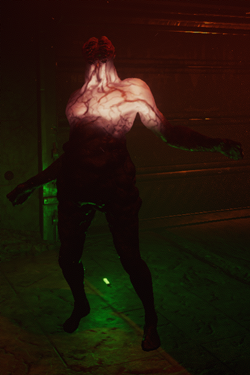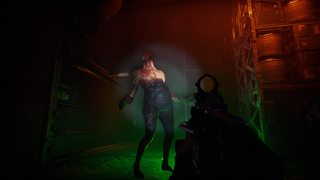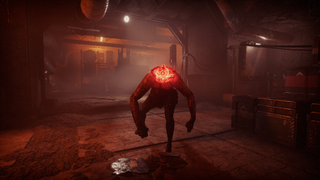Giants are large towering enemies found within The Complex. They are the larger, more durable cousins of the basic Striker enemy. They serve as tanks, soaking up gunfire and causing a drain on the player's resources.
Appearance[ | ]
Giants have a very distinguishable, disproportionate anatomy. Similarly to regular Strikers, they possess a masculine, human-like build and proportions, as well as centrally split "heads" and teeth similar to the typical Striker. Unlike their smaller counterpart, they are enormous in size at around 2.4 to 3.7 meters tall, and their heads are oddly small compared to the rest of their bodies, around the same size as a regular Striker's head. From the head to the chest they have beige coloration, and their skin appears to be see-through to some extent as well, as when light emits from them, an intricate pattern of veins become visible. Below the chest area, this palette changes into almost pure black, with no veins visible when the Giant is listening.
They make a very deep and slow growl sound when paying attention to their environment.
Spawning[ | ]
Giants have a chance to spawn in any room, unlike the Scout which only spawns in certain rooms. There are also rooms and zones in certain expeditions where they are guaranteed to spawn. Like other larger enemies, they often spawn in pairs. They can also spawn during hordes and alarms.
Behavior[ | ]
When alerted, the Giant will attempt to damage the player with one of their two forms of attack. One is their tongue attack which is similar to other Strikers', however, it has a much longer range and deals 24% damage, twice the damage of the regular Striker. Their other attack is their punch, which they will automatically do when a player gets too close to them (unless they are already attempting to tongue another player, or staggered). Their punch attack is very devastating, dealing 40% damage, and occasionally, if unlucky, you can be hit twice and take 80% damage. It is advisable not to get too close unless you are confident in your skill. Their short range attack has a small wind up time, and thus a player familiar with the distance that will trigger it can bait the Giant into performing this attack, before moving in to close range after the attack has ended.
The Giant loses its knees and arms when too much damage is inflicted to them, but make note that dismembering the arms does not affect it's melee attacks. They are also able to survive without a head or torso, allowing them to absorb large amounts of damage without dying.
If the players get too far away from the Giant, it will run to catch up.
Strategies[ | ]
Despite their strength, range and health, Giants are incredibly slow and prone to being heavily staggered. They will stagger whenever one of their body parts is broken; the parts of the body that can be broken are the head, chest, pelvis, both arms, and both legs. Staggering a Giant will prevent them from attacking for a significant period of time, drastically increasing the player's safety when dealing with them.
While their melee attack is incredibly devastating, Giants are themselves highly susceptible to charged melee attacks. Sufficiently damaging melee weapons are able to achieve enough damage to break a limb with every hit, guaranteeing a stagger. The different melee weapons vary in effectiveness against them:
- The Sledgehammer is arguably the most effective weapon against Giants. Its high damage ensures that the Giant is dispatched quickly, while its charge time is sufficiently low that the Giant only has an incredibly small window between staggers. Furthermore, the ability to sprint while charging the Sledgehammer allows the player to keep their distance while charging their attack, before quickly moving in for the hit, reducing their vulnerability to the Giant's melee attack.
- 20(charged) * 3(occiput) = 60 damage on hitting occiput at full charge (and 300 stagger)
- 20(charged) * 2(back) = 40 damage to the back at full charge
- The Knife is arguably the least effective weapon against Giants. Its damage (outside of hitting the Giant's head) is too small to guarantee a stagger, meaning that the player is incredibly susceptible to retaliation. The inability to stagger the Giant also makes it effectively useless in stealth-killing a Giant. In a group situation, let the knife player hit the Giant before it wakes up. The knife's bonus damage to weak points AND the doubled damage to sleeping enemies means that this first stab will deal just shy of half the Giant's health, but any followups will be much less effective (partially due to the Giant waking up, but also due to the occiput no longer being present).
- 5.5(charged) * 3(occiput) * 1.5(precision) * 2(sleeping) = 49.5 damage on hitting occiput at full charge whilst asleep
- 24.75 if awake
- 5.5(charged) * 2(back) * 2(sleeping) = 22 damage to the back of a sleeping Giant at full charge
- 11 if awake
- 5.5(charged) * 3(occiput) * 1.5(precision) * 2(sleeping) = 49.5 damage on hitting occiput at full charge whilst asleep
- The Bat is something of a special case. Its damage is relatively low, meaning that it takes a significant amount of time to kill even a single Giant, however, its stagger multiplier is so high and its charge time so low that the player can effectively keep Giants staggered indefinitely. In fact, it is possible (though ill advised) to solo two Giants with this weapon - by trading hits between them both can be kept staggered with only a small window for retaliation.
- 12(charged) * 3(occiput) = 36 damage on hitting occiput at full charge (and 216 stagger)
- 12(charged) * 2(back) = 24 damage to the back at full charge (144 stagger)
- The Spear is also arguably less effective against Giants, though only slightly. Its high damage and precision multiplier can allow for a devastating hit to the Giant's head. However, outside of this the Spear's charge time is slightly long, making it difficult to keep the Giant constantly staggered, though this downside is mitigated if multiple players are working together. Additionally, the inability to sprint with this weapon make it harder to move in behind the Giant and capitalize on the additional damage multiplier. The lack of sprinting can also increase the player's vulnerability to the Giant's attacks, though this is largely mitigated by the Spear's exceptional range.
- 17.5 (charged) * 3(occiput) * 1.5(precision) = 78.75 damage on hitting occiput at full charge
- 17.5(charged) * 2(back) = 35 damage to the back at full charge
Stealth[ | ]
Standard Takedown
Giants can be stealthy killed by synchronizing three sufficiently damaging fully charged melee swings, one to the occiput and two to the back. In this scenario, the low damage of either the Knife or Bat can be a significant liability - if a team has several of these lower damage weapons equipped it may require all four players to ensure a kill. Because hitting the occiput deals more damage than anywhere else on the body, but the occiput can only withstand a single full-charge hit, you should allow the player with the strongest weapon to get the first strike (Priority goes to the Spear (78.75 damage), then the Sledgehammer (60 damage), then the Knife (49.5 when sleeping), finally the Bat (36 damage)).
Sometimes, if you have one knife player on the team and no sledgehammers or spears, it may be best to let them get the first stab, in the Giant's occiput - as losing the full precision & sleeping bonuses means they are effectively useless afterwards (at best, only able to deal a mere 11 damage to the back of an awake Giant - or 22 if hitting the back of a sleeping Giant). However, the sheer damage which can be dealt to the Giant by hitting its occiput with a sledgehammer or a spear can render the knife user's potential contributions somewhat redundant anyway.
The utility of the 'hit the occiput with the knife' approach depends on what melees the rest of the team have. If two other players are armed with sledgehammers, the Giant can then be killed instantly by the team if they can land two attacks on the back immediately after the occiput stab. However, the same can also be achieved if the knife user simply lands a backstab (22), followed by a spear to the occiput (+78.75=100.75), and an uncharged hammer anywhere or a charged spear/bat to the back to finish it off - or by three hammers to the back (40 damage each) - or one spear to the occiput followed by two spears/sledgehammers to the back - or, for style points, occiput spear + back spear/hammer + 11 damage knife backstab on the non-sleeping Giant - each bypassing the need for the knife user to stab the occiput of the sleeping Giant.
Stagger Chaining
Giants can be stealthily killed by two players properly timing their hits, and staggering the Giant to prevent it from screaming and consequently waking up the room. To time this properly the first player should begin charging their melee, and once they are halfway charged the second player should do the same. Both players should immediately begin to charge their melees after each consecutive hit. This strategy can be risky as if hits are mistimed the Giant can scream, or player movements can wake up other sleepers. In this scenario the long charge time and minimal stagger of the Spear can be a significant liability, increasing the chances of the Giant having an opportunity to alert other enemies.
Loud[ | ]
Shooting
As Giants are slower than normal Strikers, it is very easy to funnel them into a choke point and quickly dispose of them. Because of their large health pool it is less effective to use main weapons to shoot them. It is ill advised to shoot Giants in the head (unless you are using the Köning PR 11 Sniper, as this will one shot the Giant). Hitting the head does not change the shots to kill by any considerable margin, and in the case of some high damage weapons like the Buckland S870 Shotgun and the Omneco LRG HEL Rifle, it does not change the number of shots to kill at all. Breaking the Giant's head also removes the ability to hit the occiput with the Sledgehammer and Spear, which instantly does half of the Giant's health with a full charge.
Team Melee
Melee killing woken up Giants is difficult and very risky, as there is a high likelihood that you will be hit with their melee and take 40% damage. When breaking a Giants limb, there is enough time to fully charge either the Sledgehammer or the Bat for a follow up hit before they have a chance to hit you with their tongue. If with another player, breaking one limb can start a stagger chain, allowing for an easier kill. Giants cannot attack while they are staggered, allowing players to easily get behind the Giant for bonus back damage.
Solo Melee
Melee killing an awoken Giant by yourself is extremely difficult and risky, as missing a single stagger will likely result in the player taking significant damage. It is important to continuously reposition yourself to be able to break one of the Giant's limbs on each hit, and to space yourself from the Giant, so as to not get hit. The Knife is arguably not viable for this strategy, as it lacks the ability to keep the Giant safely staggered.
Solo kill video guide[ | ]
Bugs[ | ]
- Breaking the Giant's chest will cause other parts of the body to not break, with the exception of the head.
Audio[ | ]
Clicking
Spasming
Alert Audio[ | ]
Roar
Gallery[ | ]
- Giant1.png
Up close
Melee killing a Giant
| ||||||||||||||





